This page intentionally left blank.
The centrality of science to modern life bestows an obligation on the scientific community to develop different and closer links with the general population. That convergence will help evolve the compact between science and society so that it will better reflect society’s current needs and values.
—Alan Leshner, 2003
Michael Faraday’s 1827 lecture series on the chemical history of a candle, intended for nonscientist participants, is an early example of the desire to bring an understanding of chemistry to the general public. The 2011 observance of an International Year of Chemistry, planned to excite young people about chemistry and raise awareness of the field’s vital role in many issues, is a more recent example. The aspiration to share chemistry with many publics is not new.
A growing body of evidence indicates that, increasingly, the public is engaging with science in a wide range of informal environments, which can be any setting outside of school such as community-based programs, festivals, libraries, or home. Yet undergraduate and graduate schools often do not prepare scientists for public communication.
This practical guide is intended for any chemist—any professional who works in chemistry-related activities, whether research, manufacturing, or policy—who wishes to communicate with the public. Whether the event will be a discussion on the chemistry of beer at a local bar or a hands-on experiment on cloud chemistry at a science fair, the goal of this guide is to help chemists improve their informal communications with the public.
At the heart of this guide is a framework, which was presented in the report Effective Chemistry Communication in Informal Environments (NASEM, 2016) and is based on the best available empirical evidence from the research literature on informal learning, science communication, and chemistry education. The framework consists of five elements, described in more detail in this guide, which can be applied broadly to any science communication event in an informal setting.
WHY COMMUNICATE?
From a chemist’s perspective, chemistry is at the heart of many of society’s conversations, including such topics as the safety of food and medicines, the consequences of ocean acidification, ensuring access to clean water, and the mechanisms and effects of climate change. For many reasons—a sense of responsibility for bringing the voice of science to conversations, a desire to share the joy of chemistry with others, a drive to encourage the next generation to pursue chemistry as a career, or others—some chemists endeavor to engage the public through public communication activities.
What motivates chemists?
Four leading goals of chemists emerged from a recent landscape study1 commissioned by the Committee on Communicating Chemistry in Informal Settings at the National Academies of Sciences, Engineering, and Medicine on the motivations for chemistry communication:
-
increase public appreciation and excitement for chemistry as a source of knowledge about the world,
-
develop scientifically informed consumers (i.e., consumers who can use chemistry information to make decisions or solve problems),
-
empower informed citizen participation in democratic processes, and
-
encourage workforce development in the chemical sciences.
Other motivations identified from research on informal science learning and science communication include developing an appreciation for science as a way of knowing and building trust.
___________________
1 The results of the landscape study are summarized in NASEM (2016) and the full landscape study report can be accessed at http://www.nas.edu/communicatingchemistry.
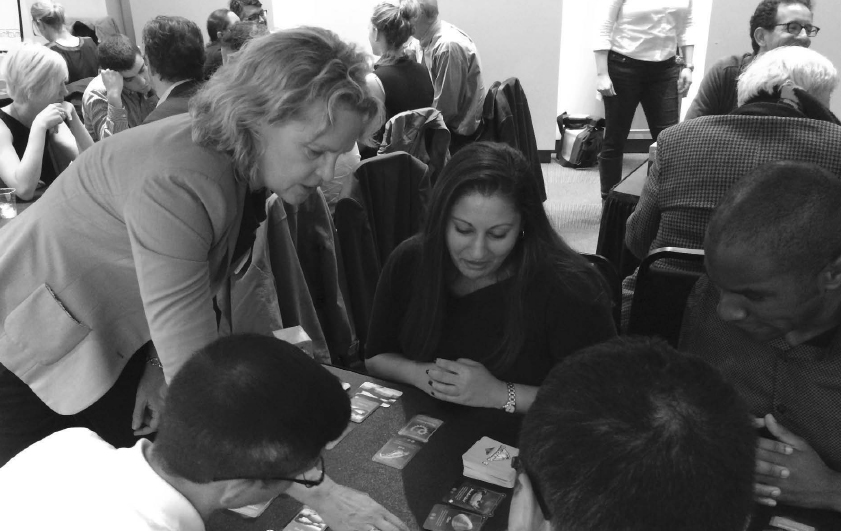
What do chemists gain?
Interactions during a public communication activity may bring a chemist unexpected insights, not only into his or her own work, but also into what is important to society, for example, local concerns about a chemical’s impact on water. They can also expose a lack of understanding about terms a chemist often uses to describe his or her research, or difficulties in understanding concepts. Excerpts from interviews conducted by Inverness Research Associates in 2009 illustrate what scientists gain from public communication activities:
-
“Every time I’ve seen a scientist engaged with the public, they get a better understanding of their own research and its contact with society, and how their research actually impacts people and the environment.”
-
A benefit of this work is “just understanding what the concerns are of the general public, what they know, and what they don’t know.”
Science Is Trusted;
Public Perceptions of Chemistry Needs More Study
Surveys show that the scientific community is among the top institutions in which Americans have the most confidence (left graph; NSB, 2014), and that survey respondents felt that chemicals make everyday life better (NSB, 2002). However, surveys also show that public understanding and interest is lower for chemistry than for some other scientific fields. For example, a recent survey of social media sharing habits indicated that articles written by chemists were the least shared of all the articles of the disciplines evaluated (right graph; Milkman and Berger, 2014). Public perceptions of chemistry need more study.
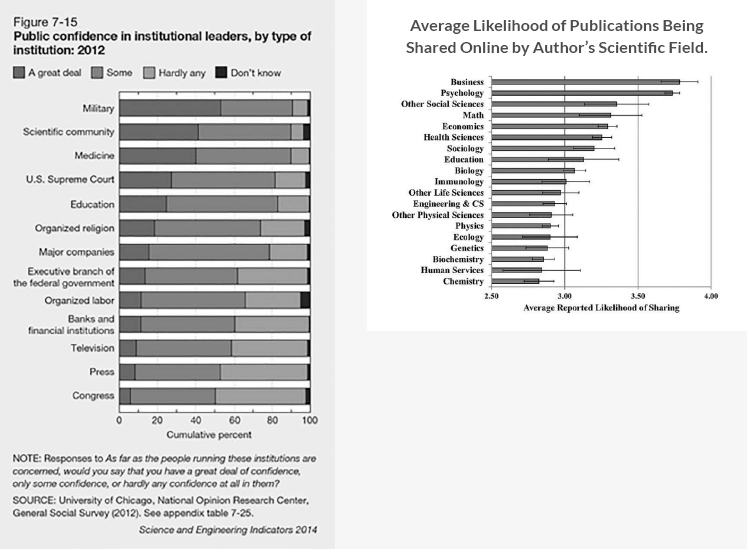
THE FRAMEWORK FOR EFFECTIVE CHEMISTRY COMMUNICATION
The framework for the design of chemistry communication events comprises five essential elements for developing and managing such events (see Sidebar 1). The main goal of the five elements is to reinforce a focus on participants—their interests, values, and perspectives—and to encourage awareness of and reflection on the needs and resources of both the event planner(s) and the participants.
These elements are not to be interpreted as rigid sequential steps, but rather as essential pieces that work together to iteratively refine goals and help build appropriate activities. The first three steps, in particular, must be considered together. For example, setting goals and outcomes (Element 1) will be refined as you consider available resources (Element 2) and the evaluation you plan to conduct (Element 3).
SIDEBAR 1:
The Framework for Effective Chemistry Communication
Element 1: Set communication goals and outcomes appropriate to the target participants.
Element 2: Identify and familiarize yourself with your resources.
Element 3: Design the communication activity and how it will be evaluated.
WHAT DOES IT MEAN TO EVALUATE? AND WHY DO IT?
A fundamental part of the framework is the need to use evaluation as a tool to make communication activities more effective at meeting their intended goals. Too often, scientists doing informal communication do not consider evaluation. Evaluation is the only way to assess whether goals and outcomes have been met. Furthermore, determining what will be evaluated at the outset of communication planning will aid in the development of a communications activity that is more likely to meet the intended goals and outcomes. The evaluation process entails learning about intended participants, gathering advanced feedback about communication design, and figuring out how to determine whether the goals and outcomes have been met.
Evaluation consists of three stages, which occur during the design, implementation, or assessment of a communication activity:
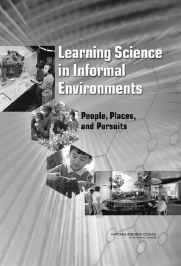
A 2009 National Research Council report, Learning Science in Informal Environments, characterizes informal science learning as predominantly “learner-motivated, guided by learner interests, voluntary, personal, ongoing, contextually relevant, collaborative, nonlinear, and open-ended.” Chemists should remember this when using the framework, which is intended to reinforce a focus on the participants.
- Front-end evaluation: Obtain information about participants to help develop or modify goals and outcomes (Element 1)
- Formative evaluation: Obtain participant responses before or during
-
an activity to assess its effectiveness before it has been fully carried out (Elements 3 and 4)
- Summative evaluation: Determine if the communication activity achieved its intended goals and outcomes (Element 5)
Evaluation does not have to be complicated or costly. It has value in its simplest form and should be scaled to the scope of the communications activity. For larger-scale activities it may be important to collaborate with a third-party expert evaluator.
USING THE FRAMEWORK
Chemists might speak at a local Rotary Club meeting or host a booth at a science festival or perhaps work with a science museum to develop a series of Saturday morning science activities for kids. Other communication activities may include giving public lectures; being interviewed on a radio program; participating in hands-on learning activities in museums; writing books, articles, blogs, and Web-based materials; and using online engagement platforms to improve public access to and understanding of chemistry. Current modes of digital communication on the Internet, such as video sharing (e.g., YouTube), social networking (e.g., Facebook), and microblogging (e.g., Twitter), present new opportunities for chemists to communicate with members of the public.
Guidance on how to use each element of the framework to plan communication events is provided. An example of a chemist making a presentation at a community center is used throughout to illustrate how the framework can be used.
ELEMENT 1
Set communication goals and outcomes appropriate to the target participants.
Element 1 centers on two key concepts: goals and outcomes. A goal is a broad statement of what the communication activity intends to accomplish. An outcome is a specific change in an individual, group, or community as a result of participation in a communication activity. The goals of any communication activity should reflect the interests, needs, and characteristics of the participants. Chemists should use knowledge of the participants to identify clear and specific goals and target outcomes and to make the experience engaging and positive. The following are guiding questions to assist in setting participant-centered goals and outcomes:

-
Who are my participants?
-
Am I targeting a particular population segment or group?
-
Do different segments have different goals?
-
Why do I want to reach these participants?
-
-
What will my participants find interesting, relevant, or engaging?
-
How can I find out what is relevant or of concern to them?
-
What prior knowledge will the participants have?
-
- What participant-relevant goals and outcomes do I want to achieve?
-
-
What will the participants get from the event?
-
What can I learn from the participants?
-
How will I know if I achieve these outcomes?
-
Who are my participants?
Information about the participants, including their level of technical knowledge and interests, is useful for developing activities that support the desired outcomes. When you begin planning, consider whether you are targeting a particular group or segment of the public. Consider characteristics such as age, technical background, and potential common interests. If the participants are children, consider possible age or developmental variations within the group. If the participants represent a broad cross-section of the public, try to determine whether they have similar goals and similar levels of knowledge on the subject matter. Participant characteristics can affect learning goals and abilities and hence can alter the appropriate communication approach. Perhaps most importantly, consider why you want to reach these participants.
As an example, you have been invited to make a presentation on the use and environmental impacts of fertilizers. The presentation will be at a local community center near a lake that has been affectedby eutrophication. Will your participants be environmental activists, the local garden club, a group of local farmers, high school students, or some combination of the above? As you can imagine, each of these groups would have different perspectives and interests, as well as varying degrees of knowledge of the topic. Can you ascertain anything about their educational or professional backgrounds?
Such information could tell you something about their level of knowledge about chemistry. Your approach to this activity should be different for each of these groups.
What will my participants find interesting, relevant, or engaging?
Social science research clearly supports the intuitive notion that people are more engaged in an activity if it is relevant to their interests and concerns. Consider how you can find out what is relevant to your intended participants.
Continuing the example above, how can you find out who will attend your presentation on fertilizers and their impacts? How can you learn what their interests might be? A good place to start is to ask the event’s organizer for participant information. Even knowing the affiliations of the registrants can be helpful. But, you may want to go further. For example, if participants are registering on a website, you could ask the organizer to add a few questions to the registration process about registrants’ interest in or level of knowledge about the topic. You could also have the organizer send a survey to registrants with a reminder of the upcoming event. If there is no preregistration, on-site assessment of interests via a show of hands or applause will at least allow you to adjust your presentation in real time if needed.
What participant-relevant goals and outcomes do I want to achieve?
Communication goals may be diverse. For example, chemists may be interested in encouraging workforce development in the chemical sciences, raising awareness about a particular area of chemical
research that is relevant to major societal concerns (like the importance of chemistry in designing the next generation of antibiotics, or improving public trust in science and chemistry). Desired participant-relevant outcomes should accompany each communication goal. The outcomes you develop will not only enable you to better focus your activity, but will also provide a basis for evaluating the success of your event. Thus, outcomes should be realistic, achievable, and measurable.

After learning about the expected participants and their interests, you might set your primary goal to increase awareness of the chemistry of fertilizers and their role in the home and in agriculture. Targeted outcomes for the participants could be
-
increasing their understanding of how some fertilizers can contribute to eutrophication,
-
increasing their awareness of available alternative fertilizers,
-
increasing their awareness of the variety of chemistry-related research being done on fertilizers and environmental impacts,
-
providing participants with information on how to contact the local agricultural extension office for guidance on home fertilizers, or
-
teaching participants how to use home soil-testing kits to monitor their own soil’s needs.
ELEMENT 2
Identify and familiarize yourself with your resources.
Once the participants and goals have been identified, the next step is to identify the resources available for implementation of your event. Creating an inventory of available resources will assist in planning and in identifying gaps or opportunities. The following questions can guide you as you consider the resources you need.
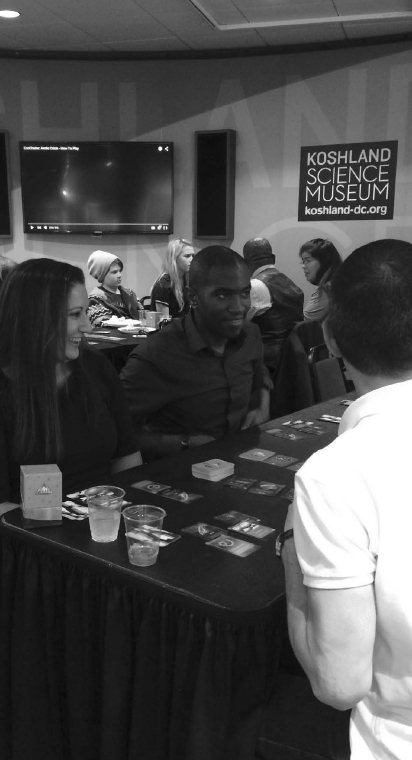
Are there organizations I can partner with?
One of the best ways to access resources is to find a group or organization to partner with. Partnering with an organization such as a science center could allow a chemist to safely implement a demonstration or hands-on activity, for example. Organizations such as the American Chemical Society and the Center for Advancement of Informal Science Education may help you identify potential collaborators and opportunities to obtain funds to support the activity. Local resources—such as a Boys & Girls Club, a library, a science or
children’s museum, or a community group—may have opportunities to participate in an existing program or to facilitate a one-time event. Potential collaborators might also be experts in informal science education or evaluation who regularly engage in the development or assessment of informal science communication activities and also promote them.
Consider collaborating with a local nongovernmental organization experienced in communicating about the environmental impacts of fertilizers. For example, the Chesapeake Bay Foundation is a conservation organization that advocates for science-based solutions to the pollution degrading the Chesapeake Bay and its rivers and streams. The organization regularly engages in outreach activities and runs several educational programs—from field experiences for students to teacher professional development classes—to boost understanding of the Bay’s poor health and of actions to improve water quality in local communities. Perhaps this organization could provide ideas for hands-on demonstrations, worksheets and online tools for participants, and also expertise in the types of participants who will likely attend and how best to work with them.
What physical resources are available, such as space, how is the space set up, and what are the safety considerations?
For activities that are in-person events (as opposed to virtual online events), the size of the event space, the number of staff, the allotted time, and monetary needs are traditional considerations that influence the type and scope of a communication activity. It is crucial to consider safety requirements for any communication activity
that involves a demonstration or interactive component. Consider whether there is adequate space for participants to handle materials and whether adequate safety equipment is available. Are seats fixed in place (as is common in auditoriums) or can they be shifted to provide a buffer of safety? Will there be sufficient time to set up and to clean up after the demonstration? Consider special audience needs as well. Other considerations can include availability of a sign-language interpreter or webcasting capabilities, which would add new dimensions to an activity.
What resources will you need for your presentation on fertilizers and their impacts? One of the outcomes you developed is to teach soil testing at the event—is the space’s layout appropriate for a demonstration or can it be configured to be so? Will you need help with the demonstration, such as additional staff or possibly audience members? Or, could it be a hands-on activity involving the participants? This might only be possible with a smaller number of participants and would require additional resources, such as multiple samples and testing kits. You could also consider collaborating with an environmental researcher who is an expert on the local lake and who can demonstrate eutrophication in a way that you cannot.
ELEMENT 3
Design the communication activity and how it will be evaluated.

Element 3 involves developing content for your event (in line with your goals and resources) and developing an evaluation plan that will enable mid-event modification and will ultimately determine whether you achieved your goals. Relying on intuition about which messages or engagement mechanisms will be most effective is not likely to succeed. Science communicators must understand what participants hope to gain from the experience and what they bring to it. Participants might, for example, be filling a gap in their understanding of the topic, might have misconceptions about it, or might need specific information. Use the questions in this section to brainstorm appropriate content, activities, delivery, and evaluation for your event.
How do I design an event that fully engages participants?
Many chemists rely on a presentation format to deliver information. However, event designs that encourage participants to think, play, and interact (with one another, with the science communicator, and with the materials and content) tend to generate the excitement,
wonder, and surprise that make the event more meaningful. Chemists can learn to effectively engage audiences from institutions that regularly engage with the public (for example, museums; see Sidebar 2).
Ensuring that content is suited to the audience is key. Analogies and visual representations, such as animations and simulations, are especially useful in helping novices understand abstract ideas and phenomena that cannot be directly observed. Also, consider having participants use the language and tools of science, for example, by choosing a problem to study, developing hypotheses about the problem, and collecting or analyzing data. Such activities foster knowledge of the scientific process, improve understanding of the relevance of science to everyday life and social issues, and develop relationships between scientists and the public.
Continuing with the content ideas you had as you considered your resources, you could decide to incorporate a hands-on soil-testing demonstration into your event. You could decide to bring soil samples from a variety of locations so that participants can compare the soil near their local lake to soil from more and less polluted areas.
How can I test the event in advance to see whether it is suitable for my participants?
A test of the communication event before the event date should be planned if possible. Testing may entail setting up a full rehearsal with test participants in the event space itself, inviting a small group of friends or colleagues to try the activity, or even just running the presentation with the event organizer. Testing will help to expose technical errors, determine whether the content
(amount and level) are appropriate, get a sense of possible participant responses, and identify space constraints or resource limitations. Testing can uncover political, social, or cultural issues that could limit participants’ engagement and learning, and can inform strategies to address those issues.
SIDEBAR 2:
Tips and Tricks: Learn from Museums!
Chemistry is not a topic usually featured in museum exhibits. Nonetheless, museums have a lot of experience interacting with members of the public that can help guide chemists’ communication activities. To fully engage publics, one model suggests that museum exhibits should elicit the following six components (NRC, 2009, p. 83):
-
Curiosity—the visitor is surprised and intrigued
-
Confidence—the visitor has a sense of competence
-
Challenge—the visitor perceives that there is something to work toward
-
Control—the visitor has a sense of self-determination and control
-
Play—the visitor experiences sensory enjoyment and playfulness
-
Communication—the visitor engages in meaningful social interaction
You could rehearse your presentation with your colleagues and encourage them to think of the potential participants (environmental activists, local farmers, etc.) and ask a range of questions. You could have them practice the hands-on soil-testing demonstration to expose potential issues and ensure you have all needed parts.
What methods should I use to evaluate my activity?
How will you know if your communication activity is effective? Measurement approaches range from casual discussion, surveys, and follow-up interviews to professional assessments. Many approaches
are quantifiable, and others are qualitative—providing insight into the value of a participant’s experience. Examples for how you could evaluate an activity are provided in Sidebar 3 and below.
For example, you decide that you might offer your fertilizer presentation again in the future, perhaps in other locales; thus, you want the evaluation to assist you in refining it. You would also like to continue your conversation with participants on the Internet. You can set up a Twitter account and plan to pass out your Twitter handle at the event or set up a blog where you will post relevant articles and accept comments and plan to pass out the website address to participants.
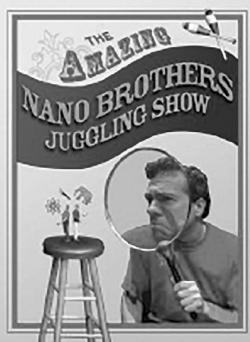
Image courtesy of Museum of Science, Boston
The Goodman Research Group conducted an evaluation of The Amazing Nano Brothers Juggling Show, a live theater performance (DVDs also available) that models the nanoscale world using juggling and storytelling. The evaluation was conducted through pre- and post-performance surveys (see Sidebar 3) and examined the show’s effectiveness at increasing participant knowledge of and interest in nanoscale science, engineering, and technology. The results showed significant increases in learning in both children and adults and also which aspects of the show resulted in the most learning. It also found that the show was captivating for participants of all ages.
SIDEBAR 3:
Example Survey Items from Evaluation of The Amazing Nano Brothers
Children’s surveys included the following examples:
-
Which is smallest? Molecule, bacteria, cell, atom, or grain of sand?
-
Is everything made of atoms?
-
Do atoms stick to each other?
-
Can scientists move individual atoms?
Questions on the teen and adult surveys were, naturally, more complex:
-
Circle the SMALLER ONE in each pair:
-
atom or nanometer
-
atom or molecule
-
microscale or nanoscale
-
bacteria or virus
-
10 million nanometers or a meter
-
100 billion nanometers or a yardstick
-
-
If the nucleus of an atom was the size of a basketball, approximately how large do you think the whole atom would be?
-
The size of a basketball hoop
-
The size of a car
-
The size of the United States
-
The size of a football stadium
-
The size of a large city
-
-
Which of the following statements do you think are true? (Choose all that apply.)
-
Everything is made of atoms.
-
Atoms can be felt with special instruments but not seen.
-
Scientists can move groups of atoms, but not individual atoms.
-
Temperature affects the movement of individual atoms.
-
Gravity affects the movement of individual atoms.
-
Products using nanotechnology are already in stores.
-
Nanotechnology has been proven safe.
-
Atoms tend to stick together.
-
None of these are true.
-
There are several ways you could evaluate the activity. You could simply conduct exit surveys or (if you have staff resources) exit interviews. You could pass out preprinted, self-addressed, stamped postcards with simple questions like “Did you like this event? Circle: Yes, Sort-of, No” and “What else would you like to have heard about?” Because you will have a Web presence, you could post a survey online and direct participants to it. You could ask for feedback during your continued conversation with participants. Or, if you intend to turn this activity into a professional endeavor, you might partner with a professional evaluator.
Have I planned for the necessary organizational and promotional requirements?
If you are the event organizer, you must publicize the event. Use the participant information you gathered (see Element 1) to consider how to properly advertise the event, both to get the word out and to attract the desired participants. If analysis of the participants’ backgrounds identified common interests, ask relevant groups (such as neighborhood email groups, Facebook groups, or hobbyist organizations) to aid in spreading the word. Other options are announcing the event through partner organizations and posting alerts on relevant social media outlets. Advertise through platforms that the target participants access regularly, whether in virtual or physical spaces, to increase the visibility of the event. Do not assume that participants will find out about the event on their own.
For your fertilizer presentation, you could begin outreach efforts with a search for local groups that are active in local environmental issues or that
regularly use the lake, and for individuals who are interested in agriculture (such as farmers and gardeners). Think about your topic broadly: perhaps visitors to a local zoo would be interested in the potential effects of fertilizer on wildlife, or perhaps visitors to a local science museum would be interested in the science of eutrophication. Invite the faculty and students of local high schools and community colleges to attend; also consider elementary and middle school audiences and parent groups. Contact local news outlets and add your event to community calendars. Do not leave outreach until the last minute; make it easy for participants to plan ahead to attend your presentation by promoting the event early.
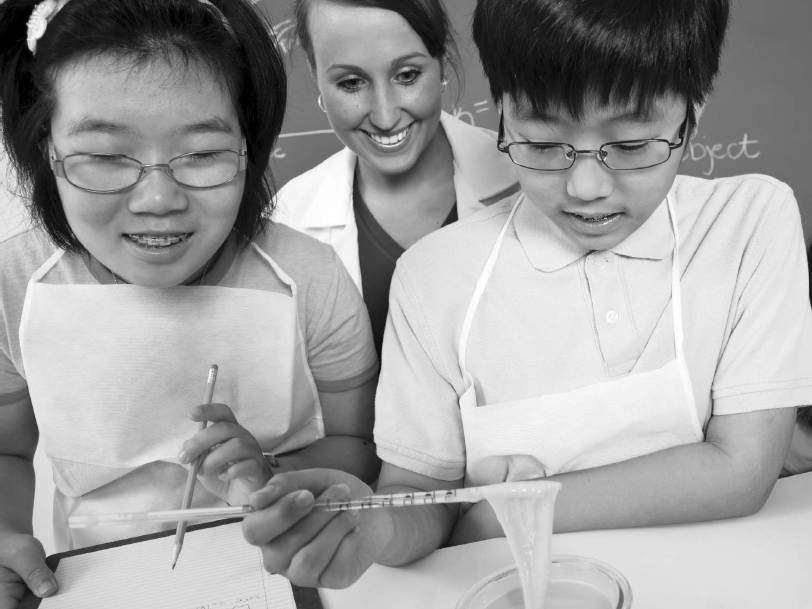
ELEMENT 4
Communicate!
The planning is done, the announcements are out, and the day has arrived. Now what? It is time to communicate. Unless you are sure that the audience has a technical background, avoid technical details like chemical structures, formulas, and technical names or use them sparingly and define them clearly. During the event, remember your evaluation plans (see the introduction and Element 3), and monitor participant reactions to make mid-event adjustments as needed. Are the participants engaged? What seems to be of particular interest? Does it make sense to focus on one topic to maintain that interest? Is the event still working toward the intended goals and outcomes? Look for additional opportunities to continue engagement after the event, such as collecting the e-mail addresses of participants who request additional information.
How do I relate to my participants to build trust?
Building trust with participants is essential for effective communication and can be a communication goal unto itself. Trust refers to people’s confidence in and willingness to open themselves up to one another. Research suggests that public perceptions of a scientist’s competence, integrity, warmth, transparency, and dependability all contribute to trust. To develop trust with the participants, you might identify and discuss shared cultural or social traits. For example, impart a life experience that illustrates your connection with chemistry
(why it matters to you) and your connection with the participants (why they matter to you).
You may not be trusted if you express strong opinions or take sides on a controversial or emotional topic, or if you work for an industry that has been accused of creating a problem, such as contributing to environmental degradation. If participants express concern (and even if they do not), do not be defensive; participants have a right to be concerned about issues. You should hear what they say, be open about why you believe your work is important, and share your own concerns.
Be aware of difficult cultural, political, or social issues
Difficult cultural, political, or social issues may distance you from participants. Perform a quick Internet search, including social media platforms, to see current discussions on topics related to your event. If you have time and resources, conduct listening sessions to learn about participant views, concerns, and values before the event. (These could be conducted as part of the participant information gathering in Element 1.) Also be aware that your professional and personal affiliations can influence a participant’s perception of you. Transparency about your affiliations and your motivations for communicating are important for building trust.
The issue of trust is likely to be important with a topic like fertilizer use and environmental impacts. You know you might have participants with strong feelings about the use of fertilizer—for example, organic gardeners, environmental activists, or farmers who need to economize to make a living—as well as different perspectives. Some will probably be listening for any indication that you have personal, financial, or political motives for making the presentation. If you conducted a test of your presentation (see Element 3), it may have uncovered potential issues that you are now encountering.
Tips and Tricks: Online Tools for Two-Way Communication
The Internet has become the primary source for science-related information, with 60 percent of the U.S. public citing it as their main source. Popular tools that enable ongoing, two-way communication include the following:
-
Reddit is a popular moderated online forum in which a chemist can participate in an Ask Me Anything: scheduled forum time to answer questions and interact with people interested in science; see https://www.reddit.com/r/science for more information
-
Twitter discussions such as #scistuchat, which is a themed, informal online discussion that occurs once per month created by a high school science teacher so that students can interact with scientists outside of school; see http://www.scistuchat.com for more information
-
ResearchBlogging.org is a website where scientists can post information about peer-reviewed work for discussion with both peers and members of the public
You could begin building trust by disclosing up front your affiliations and motivations for speaking. Ask to hear participant concerns before you begin, and acknowledge that the concerns are legitimate (even if the science behind them may not be). If the conversation becomes challenging, stay calm, listen, and try to get the event back on track. Repeat the concerns of the participants to show that you have heard them, and reinforce the idea of the event as a learning opportunity, not a forum to debate hot issues. You could reconsider information you were planning to present, to avoid additional confrontations.
ELEMENT 5
Assess, reflect, and follow up.
The framework for public communication in chemistry is an iterative process. Plan time to assess, reflect on, and follow up on your event to improve your ability to develop future events that will be effective and meaningful for you and for participants. You might ask these questions: (1) Have I achieved my intended goals and outcomes? (2) How can I apply what I learned during my communication experience to the next time?
Your presentation on fertilizer use and impacts is over. You could ask yourself these questions: Did the evaluation sufficiently determine whether you achieved your goal of increasing awareness of the chemistry of fertilizers and their role in the home and agriculture? What happened during the presentation that might inform how it was received or how you might refine it going forward? For example, did participants ask questions that indicated they understood the chemical concepts? How did the demonstration go? Will you modify or eliminate it in the future? Do you have any indications of whether you were viewed as a trusted, neutral source of information? And finally, what did you gain from the event?
CONCLUDING COMMENTS
This guide is intended not only to aid chemists and others engaged in communicating science to the public, but also to encourage engagement with the public. The example of the chemist making a presentation at the community center is designed to illustrate both the flexibility of the framework and the scalability of its steps according to the goals of the chemist conducting the activity and the activity itself. Sidebar 4 provides a second example for how the framework could be used. It is hoped that using this guide will be an enriching experience that will better equip chemists for what is fast becoming a very important aspect of being a scientist in today’s world.
SIDEBAR 4:
Using the Framework for Written Communication
If you are thinking of writing an article or a blog post, the same five elements apply.
Element 1: Are you trying to provide information? Stimulate discussion? Respond to some other article/website/tweet? Who are your intended readers? Do you know who reads the magazine/website you are posting on (based, perhaps, on looking at comments on earlier articles)?
Element 2: Do you have an editor to help you with the writing? Do you have a public affairs office that can help you reach your target audience? Will you have time to monitor responses on Twitter or on comment threads on the website? Can a student or a colleague help you do so?
Element 3: How will you decide if the article is effective: Responses from readers? “Likes” on the article’s webpage? Retweets? Messages sent to an e-mail address that you provided in the article?
Element 4: Write the article and share it!
Element 5: Look at the items you identified in Element 3. How do the responses help you plan your next article?
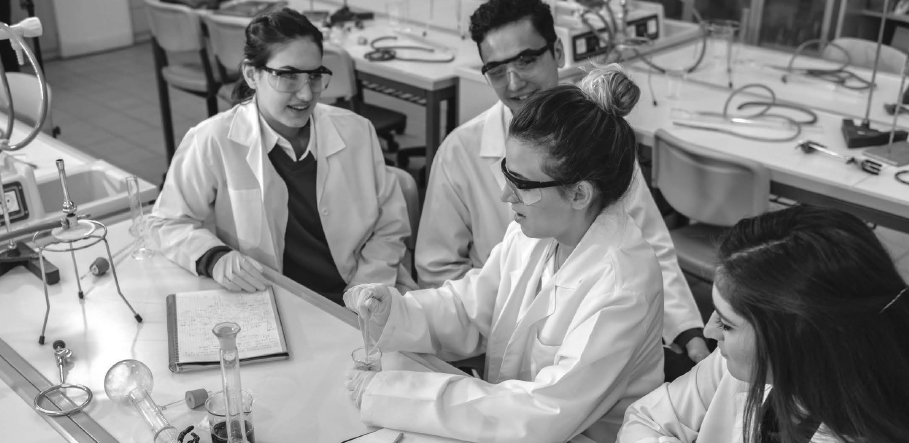
REFERENCES
Milkman, K.L., and J. Berger. 2014. The science of sharing and sharing of science. Proceedings of the National Academy of Sciences of the United States of America 111(Supplement 4):13642-13649.
NASEM (The National Academies of Sciences, Engineering, and Medicine). 2016. Effective Chemistry Communication in Informal Environments. Washington, DC: The National Academies Press.
NRC (National Research Council). 2009. Learning Science in Informal Environments: People, Places, and Pursuits. Washington, DC: The National Academies Press.
NSB (National Science Board). 2002. Science and Engineering Indicators 2002. NSB 02-01. Arlington, VA: National Science Foundation.
NSB. 2014. Science and Engineering Indicators 2014. NSB 14-01. Arlington, VA: National Science Foundation.
This page intentionally left blank.






























